Reciprocal lattice Samenvattingen, Aantekeningen en Examens
Op zoek naar een samenvatting over Reciprocal lattice? Op deze pagina vind je 15 samenvattingen over Reciprocal lattice.
Alle 15 resultaten
Sorteer op
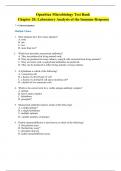
-
OpenStax Microbiology Test Bank Chapter 20: Laboratory Analysis of the Immune Response
- Tentamen (uitwerkingen) • 13 pagina's • 2024
-
Ook in voordeelbundel
-
- €13,28
- + meer info
OpenStax Microbiology Test Bank Chapter 20: Laboratory Analysis of the Immune Response * = Correct answer Multiple Choice 1. Most antigens have how many epitopes? A. none B. one C. two D. more than two* 2. Which best describes monoclonal antibodies? A. They are produced in living animals only. B. They are produced in tissue cultures, using B cells extracted from living animals.* C. They are rarely used, so polyclonal antibodies are preferred. D. They can be produced in either liv...
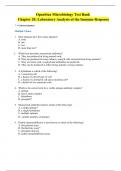
-
OpenStax Microbiology Test Bank Chapter 20: Laboratory Analysis of the Immune Response
- Tentamen (uitwerkingen) • 13 pagina's • 2024
-
Ook in voordeelbundel
-
- €13,28
- + meer info
OpenStax Microbiology Test Bank Chapter 20: Laboratory Analysis of the Immune Response * = Correct answer Multiple Choice 1. Most antigens have how many epitopes? A. none B. one C. two D. more than two* 2. Which best describes monoclonal antibodies? A. They are produced in living animals only. B. They are produced in tissue cultures, using B cells extracted from living animals.* C. They are rarely used, so polyclonal antibodies are preferred. D. They can be produced in either liv...
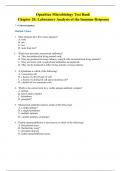
-
OpenStax Microbiology Test Bank Chapter 20: Laboratory Analysis of the Immune Response
- Tentamen (uitwerkingen) • 13 pagina's • 2024
-
- €15,64
- + meer info
OpenStax Microbiology Test Bank Chapter 20: Laboratory Analysis of the Immune Response * = Correct answer Multiple Choice 1. Most antigens have how many epitopes? A. none B. one C. two D. more than two* 2. Which best describes monoclonal antibodies? A. They are produced in living animals only. B. They are produced in tissue cultures, using B cells extracted from living animals.* C. They are rarely used, so polyclonal antibodies are preferred. D. They can be produced in either liv...
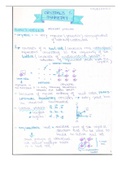
-
Crystal Structure notes
- College aantekeningen • 27 pagina's • 2022
- Ook in voordeelbundel
-
- €5,49
- + meer info
Detailed notes on every lecture with pictures included
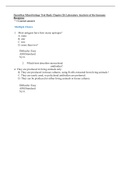
-
OpenStax Microbiology Test Bank Chapter 20: Laboratory Analysis of the Immune Response
- Tentamen (uitwerkingen) • 29 pagina's • 2022
-
Ook in voordeelbundel
-
- €14,23
- + meer info
OpenStax Microbiology Test Bank Chapter 20: Laboratory Analysis of the Immune Response Multiple Choice 1. Most antigens have how many epitopes? A. none B. one C. two D. more than two* Difficulty: Easy ASM Standard: N/A 2. Which best describes monoclonal antibodies? A. They are produced in living animals only. B. They are produced in tissue cultures, using B cells extracted from living animals.* C. They are rarely used, so polyclonal antibodies are preferred. D. They can be produc...
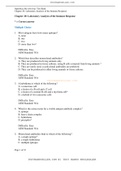
-
OpenStax Microbiology Test Bank Chapter 20: Laboratory Analysis of the Immune Response Page 1 of 18 Chapter 20: Laboratory Analysis of the Immune Response * = Correct answer | 2022 latest update
- Tentamen (uitwerkingen) • 18 pagina's • 2022
-
Ook in voordeelbundel
-
- €15,17
- + meer info
T E S T B A N K S E L L E R . C O M OpenStax Microbiology Test Bank Chapter 20: Laboratory Analysis of the Immune Response Page 1 of 18 Chapter 20: Laboratory Analysis of the Immune Response * = Correct answer Multiple Choice 1. Most antigens have how many epitopes? A. none B. one C. two D. more than two* Difficulty: Easy ASM Standard: N/A 2. Which best describes monoclonal antibodies? A. They are produced in living animals only. B. They are produced in tissue cultures, using B c...
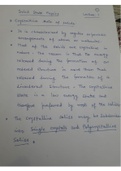
-
Amorphous and crystalline materials; Concept of lattice, unit cell, Wigner-Seitz cell, Bravais lattices, Crystal planes and Miller indices, Interplanar spacing; Packing fraction for sc, bcc and fcc structures; Common crystal structures (NaCl and CsCl); Co
- College aantekeningen • 31 pagina's • 2023
-
- €11,85
- + meer info
Amorphous and crystalline materials; Concept of lattice, unit cell, Wigner-Seitz cell, Bravais lattices, Crystal planes and Miller indices, Interplanar spacing; Packing fraction for sc, bcc and fcc structures; Common crystal structures (NaCl and CsCl); Concept of reciprocal lattice, X-ray diffraction and Bragg’s law.
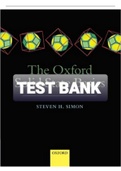
-
Exam (elaborations) TEST BANK FOR The Oxford Solid State Basics By Steven H. Simon (Solution Manual)
- Tentamen (uitwerkingen) • 196 pagina's • 2021
-
- €14,69
- + meer info
Exam (elaborations) TEST BANK FOR The Oxford Solid State Basics By Steven H. Simon (Solution Manual) The Oxford Solid State Basics Solutions to Exercises Steven H. Simon Oxford University CLARENDON PRESS . OXFORD 2015 Contents 1 About Condensed Matter Physics 1 2 Specific Heat of Solids: Boltzmann, Einstein, and Debye 3 3 Electrons in Metals: Drude Theory 15 4 More Electrons in Metals: Sommerfeld (Free Electron) Theory 21 5 The Periodic Table 35 6 What Holds Solids Together: Chemi...
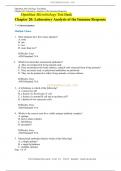
-
OpenStax Microbiology Test Bank Chapter 20: Laboratory Analysis of the Immune Response
- Tentamen (uitwerkingen) • 18 pagina's • 2024
-
- €15,64
- + meer info
Chapter 20: OpenStax Microbiology Test Bank Laboratory Analysis of the Immune Response * = Correct answer Multiple Choice 1. Most antigens have how many epitopes? A. none B. one C. two D. more than two* Difficulty: Easy ASM Standard: N/A 2. Which best describes monoclonal antibodies? A. They are produced in living animals only. B. They are produced in tissue cultures, using B cells extracted from living animals.* C. They are rarely used, so polyclonal antibodies are preferre...
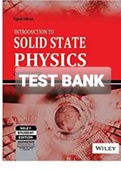
-
Exam (elaborations) TEST BANK FOR Introduction to Solid State Physics
- Tentamen (uitwerkingen) • 63 pagina's • 2022
-
- €8,49
- + meer info
Exam (elaborations) TEST BANK FOR Introduction to Solid State Physics The vectors xˆ ˆ + + y zˆ and − −xˆ yˆ + zˆ are in the directions of two body diagonals of a cube. If θ is the angle between them, their scalar product gives cos θ = –1/3, whence . 1 cos 1/ 3 90 19 28' 109 28' − θ = = ° + ° = ° 2. The plane (100) is normal to the x axis. It intercepts the a' axis at and the c' axis at ; therefore the indices referred to the primitive axes are (101). Similarly,...



